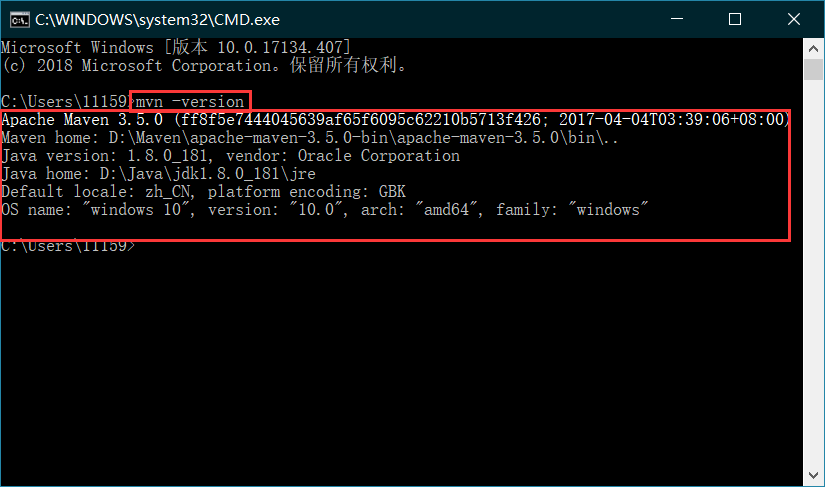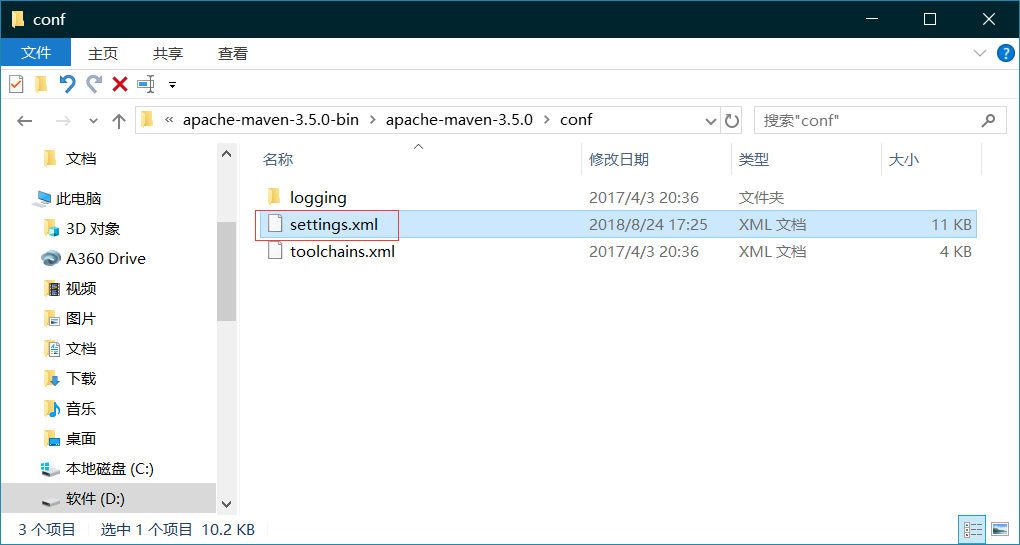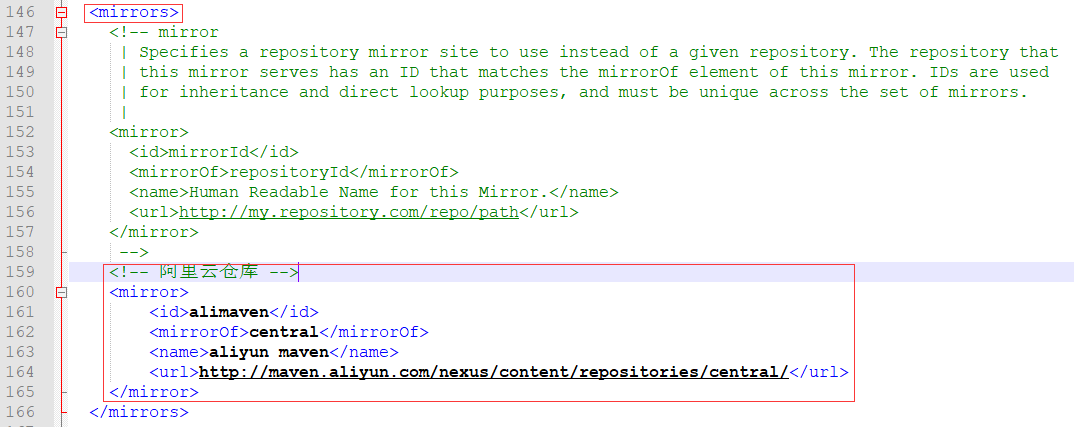环境搭建 - Maven(Windows)
Maven环境搭建
- 本文以windows7下搭建Maven-3.5.0为示例
下载Maven压缩包
- 网址:Maven

非C盘根目录下新建文件夹:Maven
- D:\Maven
- D:\Maven\Repository

在Maven目录下新建文件夹:repository(作用后面再说)
将下载好的Maven压缩包解压至建好的文件内
配置环境变量
- 进入环境变量配置步骤不再赘述,可找度娘或参考我的另一篇博客的配置步骤:https://www.cnblogs.com/brucevon/p/10059204.html
- 新建系统变量:
- 变量名:M2_HOME,变量值:D:\Maven\apache-maven-3.5.0-bin\apache-maven-3.5.0(解压路径)
- 变量名:MAVEN_HOME,变量值:D:\Maven\apache-maven-3.5.0-bin\apache-maven-3.5.0(理论上不用配置,但一些项目仍会引用MAVEN_HOME,避免日后干扰在此一起配置)
- 配置Path变量:
- 在Path变量最后添加:%M2_HOME%\bin;(注意,末尾有分号)
验证
- 打开DOS命令窗口输入:mvn -version,打印Maven版本及配置信息,搭建完成

配置修改(导包提速)
修改默认仓库(可选)
- 可使用默认默认仓库,本文以配置自己的仓库为示例
- 进入Maven目录conf文件加下找到settings.xml文件

- 在<localRepository>标签下另起一行:<localRepository>D:\Maven\repository</localRepository>(上文已建好的文件夹作为自定义本地仓库地址)

- 在<localRepository>标签下另起一行:<localRepository>D:\Maven\repository</localRepository>(上文已建好的文件夹作为自定义本地仓库地址)
修改镜像地址(必须)
- 本文以阿里云镜像为示例,其他镜像自行找度娘
- 公司内部仓库可忽略此步,IDE配置Maven时导入公司的配置文件即可
- Maven默认的仓库是国外的,导包时下载速度感人,所以改为国内的阿里云的Maven仓库,在<mirrors>标签内加入阿里云镜像的地址即可
<!-- 阿里云仓库 -->
<mirror>
<id>alimaven</id>
<mirrorOf>central</mirrorOf>
<name>aliyun maven</name>
<url>http://maven.aliyun.com/nexus/content/repositories/central/</url>
</mirror>阿里云Maven镜像

我的配置文件,步骤一样,可直接粘贴覆盖原文件
<?xml version="1.0" encoding="UTF-8"?> <!--
Licensed to the Apache Software Foundation (ASF) under one
or more contributor license agreements. See the NOTICE file
distributed with this work for additional information
regarding copyright ownership. The ASF licenses this file
to you under the Apache License, Version 2.0 (the
"License"); you may not use this file except in compliance
with the License. You may obtain a copy of the License at http://www.apache.org/licenses/LICENSE-2.0 Unless required by applicable law or agreed to in writing,
software distributed under the License is distributed on an
"AS IS" BASIS, WITHOUT WARRANTIES OR CONDITIONS OF ANY
KIND, either express or implied. See the License for the
specific language governing permissions and limitations
under the License.
--> <!--
| This is the configuration file for Maven. It can be specified at two levels:
|
| 1. User Level. This settings.xml file provides configuration for a single user,
| and is normally provided in ${user.home}/.m2/settings.xml.
|
| NOTE: This location can be overridden with the CLI option:
|
| -s /path/to/user/settings.xml
|
| 2. Global Level. This settings.xml file provides configuration for all Maven
| users on a machine (assuming they're all using the same Maven
| installation). It's normally provided in
| ${maven.conf}/settings.xml.
|
| NOTE: This location can be overridden with the CLI option:
|
| -gs /path/to/global/settings.xml
|
| The sections in this sample file are intended to give you a running start at
| getting the most out of your Maven installation. Where appropriate, the default
| values (values used when the setting is not specified) are provided.
|
|-->
<settings xmlns="http://maven.apache.org/SETTINGS/1.0.0"
xmlns:xsi="http://www.w3.org/2001/XMLSchema-instance"
xsi:schemaLocation="http://maven.apache.org/SETTINGS/1.0.0 http://maven.apache.org/xsd/settings-1.0.0.xsd">
<!-- localRepository
| The path to the local repository maven will use to store artifacts.
|
| Default: ${user.home}/.m2/repository
<localRepository>/path/to/local/repo</localRepository>
-->
<localRepository>D:\Maven\repository</localRepository>
<!-- interactiveMode
| This will determine whether maven prompts you when it needs input. If set to false,
| maven will use a sensible default value, perhaps based on some other setting, for
| the parameter in question.
|
| Default: true
<interactiveMode>true</interactiveMode>
--> <!-- offline
| Determines whether maven should attempt to connect to the network when executing a build.
| This will have an effect on artifact downloads, artifact deployment, and others.
|
| Default: false
<offline>false</offline>
--> <!-- pluginGroups
| This is a list of additional group identifiers that will be searched when resolving plugins by their prefix, i.e.
| when invoking a command line like "mvn prefix:goal". Maven will automatically add the group identifiers
| "org.apache.maven.plugins" and "org.codehaus.mojo" if these are not already contained in the list.
|-->
<pluginGroups>
<!-- pluginGroup
| Specifies a further group identifier to use for plugin lookup.
<pluginGroup>com.your.plugins</pluginGroup>
-->
</pluginGroups> <!-- proxies
| This is a list of proxies which can be used on this machine to connect to the network.
| Unless otherwise specified (by system property or command-line switch), the first proxy
| specification in this list marked as active will be used.
|-->
<proxies>
<!-- proxy
| Specification for one proxy, to be used in connecting to the network.
|
<proxy>
<id>optional</id>
<active>true</active>
<protocol>http</protocol>
<username>proxyuser</username>
<password>proxypass</password>
<host>proxy.host.net</host>
<port>80</port>
<nonProxyHosts>local.net|some.host.com</nonProxyHosts>
</proxy>
-->
</proxies> <!-- servers
| This is a list of authentication profiles, keyed by the server-id used within the system.
| Authentication profiles can be used whenever maven must make a connection to a remote server.
|-->
<servers>
<!-- server
| Specifies the authentication information to use when connecting to a particular server, identified by
| a unique name within the system (referred to by the 'id' attribute below).
|
| NOTE: You should either specify username/password OR privateKey/passphrase, since these pairings are
| used together.
|
<server>
<id>deploymentRepo</id>
<username>repouser</username>
<password>repopwd</password>
</server>
--> <!-- Another sample, using keys to authenticate.
<server>
<id>siteServer</id>
<privateKey>/path/to/private/key</privateKey>
<passphrase>optional; leave empty if not used.</passphrase>
</server>
-->
</servers> <!-- mirrors
| This is a list of mirrors to be used in downloading artifacts from remote repositories.
|
| It works like this: a POM may declare a repository to use in resolving certain artifacts.
| However, this repository may have problems with heavy traffic at times, so people have mirrored
| it to several places.
|
| That repository definition will have a unique id, so we can create a mirror reference for that
| repository, to be used as an alternate download site. The mirror site will be the preferred
| server for that repository.
|-->
<mirrors>
<!-- mirror
| Specifies a repository mirror site to use instead of a given repository. The repository that
| this mirror serves has an ID that matches the mirrorOf element of this mirror. IDs are used
| for inheritance and direct lookup purposes, and must be unique across the set of mirrors.
|
<mirror>
<id>mirrorId</id>
<mirrorOf>repositoryId</mirrorOf>
<name>Human Readable Name for this Mirror.</name>
<url>http://my.repository.com/repo/path</url>
</mirror>
-->
<!-- 阿里云仓库 -->
<mirror>
<id>alimaven</id>
<mirrorOf>central</mirrorOf>
<name>aliyun maven</name>
<url>http://maven.aliyun.com/nexus/content/repositories/central/</url>
</mirror>
</mirrors> <!-- profiles
| This is a list of profiles which can be activated in a variety of ways, and which can modify
| the build process. Profiles provided in the settings.xml are intended to provide local machine-
| specific paths and repository locations which allow the build to work in the local environment.
|
| For example, if you have an integration testing plugin - like cactus - that needs to know where
| your Tomcat instance is installed, you can provide a variable here such that the variable is
| dereferenced during the build process to configure the cactus plugin.
|
| As noted above, profiles can be activated in a variety of ways. One way - the activeProfiles
| section of this document (settings.xml) - will be discussed later. Another way essentially
| relies on the detection of a system property, either matching a particular value for the property,
| or merely testing its existence. Profiles can also be activated by JDK version prefix, where a
| value of '1.4' might activate a profile when the build is executed on a JDK version of '1.4.2_07'.
| Finally, the list of active profiles can be specified directly from the command line.
|
| NOTE: For profiles defined in the settings.xml, you are restricted to specifying only artifact
| repositories, plugin repositories, and free-form properties to be used as configuration
| variables for plugins in the POM.
|
|-->
<profiles>
<!-- profile
| Specifies a set of introductions to the build process, to be activated using one or more of the
| mechanisms described above. For inheritance purposes, and to activate profiles via <activatedProfiles/>
| or the command line, profiles have to have an ID that is unique.
|
| An encouraged best practice for profile identification is to use a consistent naming convention
| for profiles, such as 'env-dev', 'env-test', 'env-production', 'user-jdcasey', 'user-brett', etc.
| This will make it more intuitive to understand what the set of introduced profiles is attempting
| to accomplish, particularly when you only have a list of profile id's for debug.
|
| This profile example uses the JDK version to trigger activation, and provides a JDK-specific repo.
<profile>
<id>jdk-1.4</id> <activation>
<jdk>1.4</jdk>
</activation> <repositories>
<repository>
<id>jdk14</id>
<name>Repository for JDK 1.4 builds</name>
<url>http://www.myhost.com/maven/jdk14</url>
<layout>default</layout>
<snapshotPolicy>always</snapshotPolicy>
</repository>
</repositories>
</profile>
--> <!--
| Here is another profile, activated by the system property 'target-env' with a value of 'dev',
| which provides a specific path to the Tomcat instance. To use this, your plugin configuration
| might hypothetically look like:
|
| ...
| <plugin>
| <groupId>org.myco.myplugins</groupId>
| <artifactId>myplugin</artifactId>
|
| <configuration>
| <tomcatLocation>${tomcatPath}</tomcatLocation>
| </configuration>
| </plugin>
| ...
|
| NOTE: If you just wanted to inject this configuration whenever someone set 'target-env' to
| anything, you could just leave off the <value/> inside the activation-property.
|
<profile>
<id>env-dev</id> <activation>
<property>
<name>target-env</name>
<value>dev</value>
</property>
</activation> <properties>
<tomcatPath>/path/to/tomcat/instance</tomcatPath>
</properties>
</profile>
-->
</profiles> <!-- activeProfiles
| List of profiles that are active for all builds.
|
<activeProfiles>
<activeProfile>alwaysActiveProfile</activeProfile>
<activeProfile>anotherAlwaysActiveProfile</activeProfile>
</activeProfiles>
-->
</settings>
settings.xml
环境搭建 - Maven(Windows)的更多相关文章
- PHP.6-PHP环境搭建(Windows环境下)-LAMP
PHP环境搭建(Windows环境下)-LAMP Windows系统上分别独立安装Apache2.PHP5.MySQL5和phpMyAdmin等几个软件.独立安装的好处是可以自由选择这些组件的具体版本 ...
- Python环境搭建(Windows)
·Python环境搭建(Windows) @ 下载Python Python官网:https://www.python.org/ Python帮助文档下载地址:https://www.python ...
- Nginx 环境搭建 (windows)
Nginx 环境搭建 (windows) 资源 # nginx在线文档和支持 For online documentation and support please refer to nginx.or ...
- Jmeter学习一:Jmeter性能测试环境搭建(Windows下)
最近刚开始接触Jmeter性能测试,现总结环境搭建如下: 一.windows安装JDK步骤与环境变量配置: 1.先将下载的JDK安装到其默认目录:C:\Program Files\Java\jdk1. ...
- 微信小程序的开发环境搭建(Windows版本)
前言: 小程序是指微信公众平台小程序,小程序可以帮助开发者快速的开发小程序,小程序可以在微信内被便捷地获取和传播:是一种不需要下载安装即可使用的应用小程序,和原有的三种公众号是并行的体系.2017年1 ...
- Python+Selenium+webdriver环境搭建(windows)以及相关资源下载链接
今天记录一下测试小菜鸟alter在测试入门的一点关于python+Selenium+webdriver环境搭建的经历以及资源分享.欢迎交流学习,批评指正. 一.Python的下载与安装 1.pytho ...
- selenium自动化环境搭建(Windows)
参考内容:虫师<selenium2自动化测试实战-基于python语言> 一.selenium介绍 selenium主要用于web应用程序的自动化测试,还支持所有基于web的管理任务自动化 ...
- Scala学习1————scala开发环境搭建(windows 10)
Scala开发环境搭建 先讲几点我学习scala的目的或者原因吧: JVM在企业中的霸主地位,Scala也是JVM上的语言,很有可能未来会从Java过度到Scala也不是不可能. 先进的函数式编程和面 ...
- 重新学习ESP32(零)之环境搭建——转载——windows平台
原文来自:https://www.makingfun.xyz/2018/09/18/esp32-hello-world/ 前言 前几天看到乐鑫的公众号推送了一篇文章,说是ESP8266最新的SDK风格 ...
随机推荐
- Ajax级联选择框
Ajax级联选择框 级联选择框常用与比较负责的网页开发,例如实现的商品添加页面中,需要选择商品的分类,而分类信息又有层次,例如大分类和小分类就是两层级联,在用户选择商品所属大类时,所属小类的内容需要根 ...
- SSIS - 4.使用表达式任务和脚本任务实现更改变量和输出变量值
一.脚本任务 脚本任务是SSIS包中功能很强大的组件,尤其当内置的任务无法实现我们需要的功能的时候,我们都可以使用脚本任务来实现.脚本任务使用VSTA(Microsoft Visual Studio ...
- easyui自定义皮肤及缺陷修改
引言: 一个商业项目的需要,又因为时间紧迫的关系,准备购买一套简洁,易用,可定制化强的UI,经过对国内外多家UI产品进行了对比, 包括:FineUI, EasyUI, EXT.NET, EXTJS, ...
- SDL 开发实战(七): 使用 SDL 实现 PCM播放器
在上文,我们做了YUV播放器,这样我们就入门了SDL播放视频.下面我们来做一个PCM播放,即使用SDL播放PCM数据. 下面说明一下使用SDL播放PCM音频的基本流程,主要分为两大部分:初始化SDL. ...
- [Swift]LeetCode974. 和可被 K 整除的子数组 | Subarray Sums Divisible by K
Given an array A of integers, return the number of (contiguous, non-empty) subarrays that have a sum ...
- 基于Spring Boot、Spring Cloud、Docker的微服务系统架构实践
由于最近公司业务需要,需要搭建基于Spring Cloud的微服务系统.遍访各大搜索引擎,发现国内资料少之又少,也难怪,国内Dubbo正统治着天下.但是,一个技术总有它的瓶颈,Dubbo也有它捉襟见肘 ...
- ASP.NET Core Web API 与 SSL
SSL 一直没有真正研究过SSL,不知道下面的理解是否正确. SSL是Secure Sockets Layer的缩写,它用来保护服务器和客户端之前的通信.它是基于信任+加密的概念. 在介绍SSL的原理 ...
- Python内置函数(39)——locals
英文文档: locals() Update and return a dictionary representing the current local symbol table. Free var ...
- Git的使用--如何将本地项目上传到Github(三种简单、方便的方法)
一.第一种方法: 1.首先你需要一个github账号,所以还没有的话先去注册吧! https://github.com/ 我们使用git需要先安装git工具,这里给出下载地址,下载后一路(傻瓜式安装) ...
- java基础(五)-----关键字static
在Java中并不存在全局变量的概念,但是我们可以通过static来实现一个“伪全局”的概念,在Java中static表示“全局”或者“静态”的意思,用来修饰成员变量和成员方法,当然也可以修饰代码块. ...
